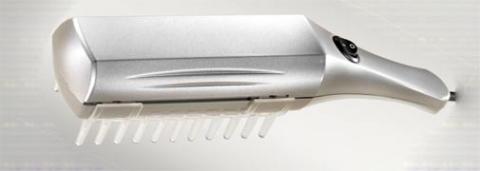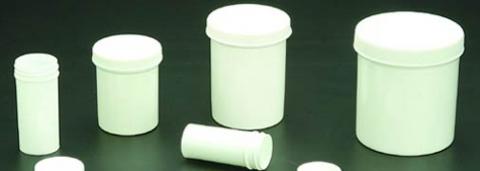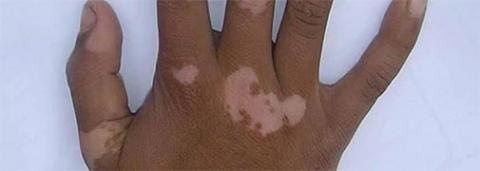Prostaglandin E2 is of the prostaglandins, a group of hormone-like substances that participate in a wide range of body functions such as the contraction and relaxation of smooth muscle, the dilation and constriction of blood vessels, control of blood pressure, and modulation of inflammation. Prostaglandin E2 (PGE-2) is released by blood vessel walls in response to infection or inflammation that acts on the brain to induce fever. The enzyme mPGES-1 is involved in the production of PGE2 and is an important "switch" for activating the fever response.Prostaglandin E2 (PGE2) has stimulant and immunomodulatory effects on melanocytes and regulates their proliferation. In order to study the efficacy and safety of topical PGE2 in treating stable vitiligo patches involving less then 5% body surface here is what researchers from the Lokmanya Tilak Municipal General Hospital, Dept. of Dermatology in Mumbai, India experimented:
Vitiligo has been reported among some species of domestic and wild animals. Some of these occurrences have been documented by veterinary journals and publications. Buffalo The September 1990 issue of Buffalo Bulletin, reports that a female buffalo in Pakistan has developed white patches on the ventral skin of the belly. The pregnant cow, rapidly became hypersensitive to flies and sunlight. The condition hasn't been passed to her offspring. The same article reports that by 1965 there were only two recorded occurrences of vitiligo among buffaloes. (Luekoderma in Buffalo, Hussain N.)
A study performed by researchers in Iran concluded that nbUVB vitiligo treatments are more successful when asociated with topical immunomodulators (Elidel, Protopic). "Sixty-eight patients with vitiligo enrolled in this randomized, double-blind, placebo-controlled study. The patients were randomized into two groups and treated with NB-UVB plus either pimecrolimus or placebo for 3 months. Tri-weekly radiation was started at 280 mj/cm2, with 15% increments for each subsequent treatment until erythema was reported or a maximum of 800 mj/cm was achieved. At baseline and 6 and 12weeks after commencement of therapy, vitiliginous patches were measured. Fifty patients completed the 3-month study. No significant side effects except self-limited erythema and pruritus were observed. After 12weeks of treatment, repigmentation of the facial lesions was higher in patients treated with combined pimecrolimus and NB-UVB compared with the placebo plus NB-UVB group (64.3 vs 25.1%) (p 0.05%). There was no statistically significant difference in the repigmentation rate between the two groups on other body areas," wrote I. Esfandiarpour and colleagues. Their findings tell us that a vitiligo treatment should be dependant on the body area where the white patches are located. While tacrolimus may be used effectively on the face (with or without UVB) it's efficiency in other areas (feet, elbows, hands) is limited.
Many of the known treatments for vitiligo rely on daily ointment applications. But do we know how to properly apply the ointment and in what quantity ? Here are some guidelines on how much ointment to apply to your vitiligo spots. The amount of steroid the patient should apply to a particular area can be determined by using the fingertip unit method. A fingertip unit is defined as the amount that can be squeezed from the fingertip to the first crease of the finger. The table below describes the number of fingertip units needed to cover specific areas of the body. One hand-size area (i.e., the area of one side of the hand) of skin requires 0.5 fingertip units or 0.25 g of steroid. The amount dispensed and applied should be considered carefully because too little steroid can lead to a poor response, and too much can increase side effects. Fingertip unit dosage for several areas These indications can be used both when treating vitiligo with topical immunomodulators (Protopic, Elidel) and corticosteroids.
Researchers at the Tehran Royan Institute are taking advantage of Iran's open embrionic research programs. A team lead by Dr Baharvand claims to have pioneered a procedure that uses the patient's own stem cells to cure vitiligo. This research focuses on induced pluripotent stem (IPS), adult stem cells which are made to act like embryonic ones - they gain the ability to become any cell in the human body. Rather than managing the symptoms of the disease, they would be used to regenerate the affected parts of the body. Read a comprehensive interview with Dr. Nasser Aghdami here: Interview with Dr. Nasser Aghdami from Royan Cell Therapy Center {"preview_thumbnail":"/sites/default/files/styles/video_embed_wysiwyg_preview/public/video_thumbnails/VUaCMIYYTNE.jpg?itok=ZJRWxtPb","video_url":"https://www.youtube.com/watch?v=VUaCMIYYTNE","settings":{"responsive":1,"width":"854","height":"480","autoplay":0},"settings_summary":["Embedded Video (Responsive)."]}
Vitiligo affects between 0.1-2% of the population. Some recent studies have calculated the incidence among Italian males to be 0.17 and among Indians 1.84%. In 50% of the patients, vitiligo onsets before the age of 18. It can occur at any age but usually peaks between ages 10-30. There have been cases of vitiligo occuring even after the age of 50. Everyone can get vitligo, there are no racial, ethnic or socioeconomic associations. Vitiligo patients can be diagnosed with two variations of the disease: segmental nonsegmental vitiligo Segmental vitiligo usualy appears on one side of the body (unilateral involvement), has an early onset and rapid progression. This type of vitiligo is most likely linked to neurological disorders. Nonsegmental vitiligo represents 72-95% of the vitiligo cases. It is usually symetric and new patches appear throughtout one's life. This type of the vitiligo has most likely autoimune origins. Risk Factors 20-30% of vitiligo patients have a first or second-degree relative with the diesease. Another risk factor is represented by a stressful life event in the last 12 months. Vitligo onset may be triggered by other events such as pregnancy, sunburn or skin trauma. Sometimes, vitiligo is asociated with a couple of other autoimune disorders such as:
One of the promising vitiligo treatments relies on piperine, the main compound in black pepper to stimulate pigment cells (melanocytes) reproduce faster thus repigmenting the white patches. At present, piperine research focuses more on mice than on humans but nevertheless news that scientists are getting involved into the vitiligo cause, can only lead to positive results for us, the patients. Currently , there are many piperine based products available as a food additive but none are used for skin applications. No studies have been conducted on how the body reacts on the long term to piperine. I have read on a number of forums, that people have started preparing their own pepper based products, getting bored of waiting for the official medical treatment. Surprisingly, some are claiming to have positive results, in the form of freckles inside the white vitiligo patches, the first step towards repigmentation. Here are some of the 'recipes': 5 drops of black pepper essential oil (can be found in any Indian supply store or online) mixed with one ounce of base cream. 200 ml refined alcohol mixed with 20g of grounded black pepper is left in a jar for 1-2 weeks until the color changes. Each day the mixture must be stirred. In the end, the mixture can be filtered with a coffee filter paper or napkin. It is applied topically on the white spots with a cotton cub, avoiding sensitive areas (eyes, mouth)






